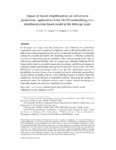Mostrar o rexistro simple do ítem
Impact of model simplifications on soil erosion predictions: application of the GLUE methodology to a distributed event-based model at the hillslope scale
| dc.contributor.author | Cea, Luis | |
| dc.contributor.author | Legout, Cédric | |
| dc.contributor.author | Grangeon, Thomas | |
| dc.contributor.author | Nord, Guillaume | |
| dc.contributor.other | Enxeñaría da Auga e do Medio Ambiente (GEAMA) | es_ES |
| dc.date.accessioned | 2024-02-14T20:15:48Z | |
| dc.date.available | 2024-02-14T20:15:48Z | |
| dc.date.issued | 2016 | |
| dc.identifier.citation | Cea, L., Legout, C., Grangeon, T., & Nord, G. (2016). Impact of model simplifications on soil erosion predictions: application of the GLUE methodology to a distributed event‐based model at the hillslope scale. Hydrological Processes, 30(7), 1096-1113. https://doi.org/10.1002/hyp.10697 | es_ES |
| dc.identifier.uri | http://hdl.handle.net/2183/35603 | |
| dc.description | Versión aceptada de https://doi.org/10.1002/hyp.10697 | es_ES |
| dc.description.abstract | [Abstract:] In this paper, we analyse how the performance and calibration of a distributed event-based soil erosion model at the hillslope scale is affected by different simplifications on the parameterizations used to compute the production of suspended sediment by rainfall and runoff. Six modelling scenarios of different complexity are used to evaluate the temporal variability of the sedimentograph at the outlet of a 60 m long cultivated hillslope. The six scenarios are calibrated within the generalized likelihood uncertainty estimation framework in order to account for parameter uncertainty, and their performance is evaluated against experimental data registered during five storm events. The Nash–Sutcliffe efficiency, percent bias and coverage performance ratios show that the sedimentary response of the hillslope in terms of mass flux of eroded soil can be efficiently captured by a model structure including only two soil erodibility parameters, which control the rainfall and runoff production of suspended sediment. Increasing the number of parameters makes the calibration process more complex without increasing in a noticeable manner the predictive capability of the model. | es_ES |
| dc.description.sponsorship | Field data were obtained within the HyMeX programme and sponsored by Rhône-alpes région, grants MISTRALS/HyMeX, ANR-2011-BS56-027 FLOODSCALE project and OHMCV (http://www.ohmcv.fr). OHMCV is supported by the Institut National des Sciences de l'Univers (INSU/CNRS), the French Ministry for Education and Research, the Observatoire des Sciences de l'Univers de Grenoble (OSUG/Grenoble University) and the SOERE Réseau des Bassins Versants (Alliance Allenvi). Data collection and sediment concentration measurements were carried out by Simon Gérard, who had a HyMeX CNRS contract. The assistance of Jean Marie Miscioscia and Henri Mora in building and setting up the flume on the field is acknowledged. The help of Romain Biron and Fred Malinur during field measurements was appreciated. | es_ES |
| dc.description.sponsorship | Francia. Hydrological cycle in Mediterranean Experiment; ANR-2011-BS56-027 | es_ES |
| dc.language.iso | eng | es_ES |
| dc.publisher | Wiley | es_ES |
| dc.relation.uri | https://doi.org/10.1002/hyp.10697 | es_ES |
| dc.rights | © 2015 John Wiley & Sons, Ltd. | es_ES |
| dc.subject | Soil erosion | es_ES |
| dc.subject | Rainfall runoff | es_ES |
| dc.subject | Physically-based model | es_ES |
| dc.subject | Model calibration | es_ES |
| dc.subject | Model validation | es_ES |
| dc.subject | GLUE | es_ES |
| dc.title | Impact of model simplifications on soil erosion predictions: application of the GLUE methodology to a distributed event-based model at the hillslope scale | es_ES |
| dc.type | info:eu-repo/semantics/article | es_ES |
| dc.rights.access | info:eu-repo/semantics/openAccess | es_ES |
| UDC.journalTitle | Hydrological Processes | es_ES |
| UDC.volume | 30 | es_ES |
| UDC.startPage | 1096 | es_ES |
| UDC.endPage | 1113 | es_ES |
| dc.identifier.doi | 10.1002/hyp.10697 |






